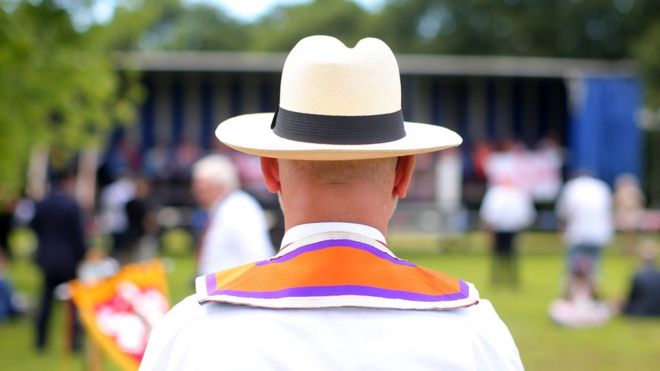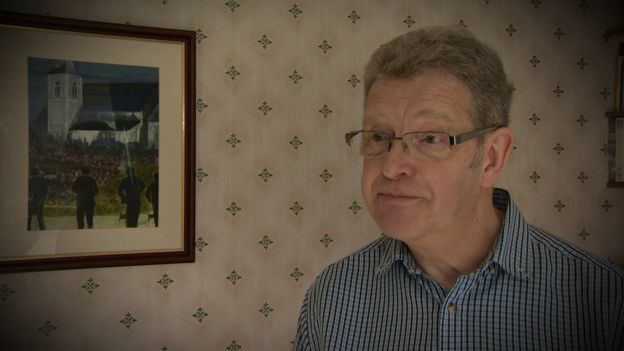How one priest saved countless souls in the First World War

The sun sets behind the Cross of Sacrifice in Passchendaele (Getty)
Fr William Doyle showed staggering courage at Passchendaele
Like so many caught up in the conflict that came to be known as the Great War, Fr Willie Doyle was buried where he fell, without a marker, just another casualty among millions. He might have been forgotten; however, it proved not to be the case.
Before his death, he had requested that his private papers be burned. Thankfully, his wishes were ignored. The discovery of the papers, and their subsequent publication as part of a biography published in 1920, were a surprise to those who had known him.
After days spent giving retreats, hearing confessions and, above all, saying Holy Mass, his spiritual notebooks revealed another dimension of Fr Doyle. Hours were spent at night in long watches in front of the Blessed Sacrament, praying for the sanctity of priests. Then there was the frequent use of the discipline (whip), immersion in cold lakes, and nocturnal, barefoot pilgrimages in reparation of sins. All this was hidden from view, but, importantly, with the knowing approval of the Jesuit’s spiritual director. And then there was his less dramatic daily “war” on self: for instance, the “Butter Tragedy” – some days butter on his toast, others not, just one example of a constant spirit of mortification in everyday matters.
The personal papers revealed an intense inner life that edified some. Others deemed his mortifications too harsh, his prayer life too extreme; and yet, this was a man with a reputation unlike that of any gloomy ascetic. He was a much loved, affable priest, a perpetual prankster. This paradox only seemed to deepen the mystery surrounding Fr Doyle.
Willie Doyle was born in Dublin on March 3, 1873. His parents were both well-to-do and devoutly religious. Four of their seven children entered some form of religious life. Having been educated in both Ireland and England, Willie entered the Society of Jesus.
Finally, he was ordained in 1907, and soon after was assigned to the Jesuit mission to parishes throughout the British Isles. From the start he excelled as preacher and confessor. Crowds flocked to him, but only after his death was the secret of his “success” revealed: penance.
When war broke out in 1914, Fr Doyle volunteered immediately. He understood that, with thousands on their way to death, a priest was needed for what would prove to be the decisive hour for many souls, with all lost or gained, and for all eternity.
In 1915, he landed in France with the Royal Irish Fusiliers. From then on, he marched every mile alongside these soldiers – forgoing all privileges that his officer rank afforded him. By the end, these battle-hardened troops would come to love their Padre. It was no surprise, as he suffered as much as they did. Through barbed wire, and in spite of bullets, shells and gas, Fr Doyle sought out the dying, who often lay terrified and alone in mud-filled battlefields, administering the last rites, bringing Viaticum.
For his bravery, Fr Doyle was mentioned in despatches and recommended for the highest award for gallantry, the Victoria Cross. He was passed over, deemed by some to have had a triple disqualification: Irish, Catholic and Jesuit. It was to make little difference. His eyes were on an altogether greater prize: the sanctity and the salvation of the men in his charge.
As if the dangers and privations of the Front were not enough, throughout it all Fr Doyle continued his own inner “war”. When possible, in those flooded, fetid trenches, with the sounds of hell reverberating all around, the priest, with a pyx containing the Eucharist around his neck, spent hours on his knees adoring the Prince of Peace.
His letters home to his widowed father reveal the strain of it all as he marched on through the bloodstained fields, with names later synonymous with suffering: Loos, the Somme, Passchendaele … Like his comrades, he was shot at, shelled and gassed, narrowly missing being killed on numerous occasions, his only rest being in the same rat-infested trenches. Despite his brother officers’ pleas, he refused to leave the Front, determined to remain until the end.
On August 16, 1917, during the seemingly never-ending Passchendaele offensive, Fr Doyle was desperately trying to drag a wounded comrade back to safety from No Man’s Land. He was blown to pieces by a German shell. Unlike the many to whom he had given a Christian burial, his remains were hastily interred in a makeshift communal grave.
As the 100th anniversary of his death draws near, it is worth recalling that on the Western Front alone an estimated 40,000 military personnel converted to the Catholic faith. No doubt, this was due in no small measure to the exemplary service of Catholic chaplains – holy men such as Fr Willie Doyle.
KV Turley is a writer and filmmaker. He is the author of Fr Willie Doyle & World War I: A Chaplain’s Story (CTS)
This article first appeared in the July 28 2017 issue of the Catholic Herald. To read the magazine in full, from anywhere in the world, go here



